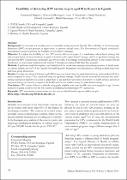Feasibility of delivering HPV vaccine to girls aged 10 to 15 years in Uganda
| dc.contributor.author | Mugisha, Emmanuel | |
| dc.contributor.author | LaMontagne, Scott | |
| dc.contributor.author | Katahoire, Anne R | |
| dc.contributor.author | Murokora, Daniel | |
| dc.contributor.author | Kumakech, Edward | |
| dc.contributor.author | Seruyange, Rachel | |
| dc.contributor.author | Tsu, Vivien Davis | |
| dc.date.accessioned | 2020-11-11T07:06:31Z | |
| dc.date.available | 2020-11-11T07:06:31Z | |
| dc.date.issued | 2015 | |
| dc.identifier.citation | Mugisha, E., LaMontagne, D. S., Katahoire, A. R., Murokora, D., Kumakech, E., Seruyange, R., & Tsu, V. D. (2015). Feasibility of delivering HPV vaccine to girls aged 10 to 15 years in Uganda. African health sciences, 15(1), 33-41. | en_US |
| dc.identifier.uri | https://hdl.handle.net/123456789/187 | |
| dc.description.abstract | Background: Cervical cancer is a leading cause of mortality among women in Uganda. The availability of the human papillomavirus (HPV) vaccine presents an opportunity to prevent cervical cancer. The Government of Uganda conducted a demonstration project exploring the feasibility of two delivery strategies. Objective: To explore the feasibility of two HPV vaccine delivery strategies: 1) a stand-alone school-based strategy that selected girls based on their enrolment in grade 5 (known as the “grade-based” strategy; and 2) an age-based strategy that delivered the HPV vaccine based on the girls’ age (10-year-olds). This strategy combined the delivery of the vaccine with the distribution of deworming medication and vitamin A through an existing Child Days Plus program. Methods: A qualitative study that explored the feasibility of the two delivery strategies from the perspective of health workers, district leaders, and staff of the Uganda National Expanded Programme on Immunization, utilizing in-depth interviews and focus group discussions. Results: Coverage data showed that more girls (88%) were vaccinated using the grade-based strategy and completed all three doses compared to those (73%) vaccinated using the age-based strategy. Health workers and teachers indicated that determining vaccination eligibility was easier by grade than by age and there were minor disruptions to health services and school programs during vaccinations, as reported by health workers and teachers using the grade-based strategy. Conclusion: HPV vaccine delivery at schools using grade eligibility was more feasible than selecting girls by age. Lessons learned in Uganda could be relevant for countries considering implementing HPV vaccinations. | en_US |
| dc.language.iso | en | en_US |
| dc.publisher | African health sciences | en_US |
| dc.subject | HPV | en_US |
| dc.subject | vaccination | en_US |
| dc.subject | immunization | en_US |
| dc.subject | cervical cancer | en_US |
| dc.subject | school-based program | en_US |
| dc.subject | adolescent girls | en_US |
| dc.title | Feasibility of delivering HPV vaccine to girls aged 10 to 15 years in Uganda | en_US |
| dc.type | Article | en_US |
Files in this item
This item appears in the following Collection(s)
-
Research Articles [36]

